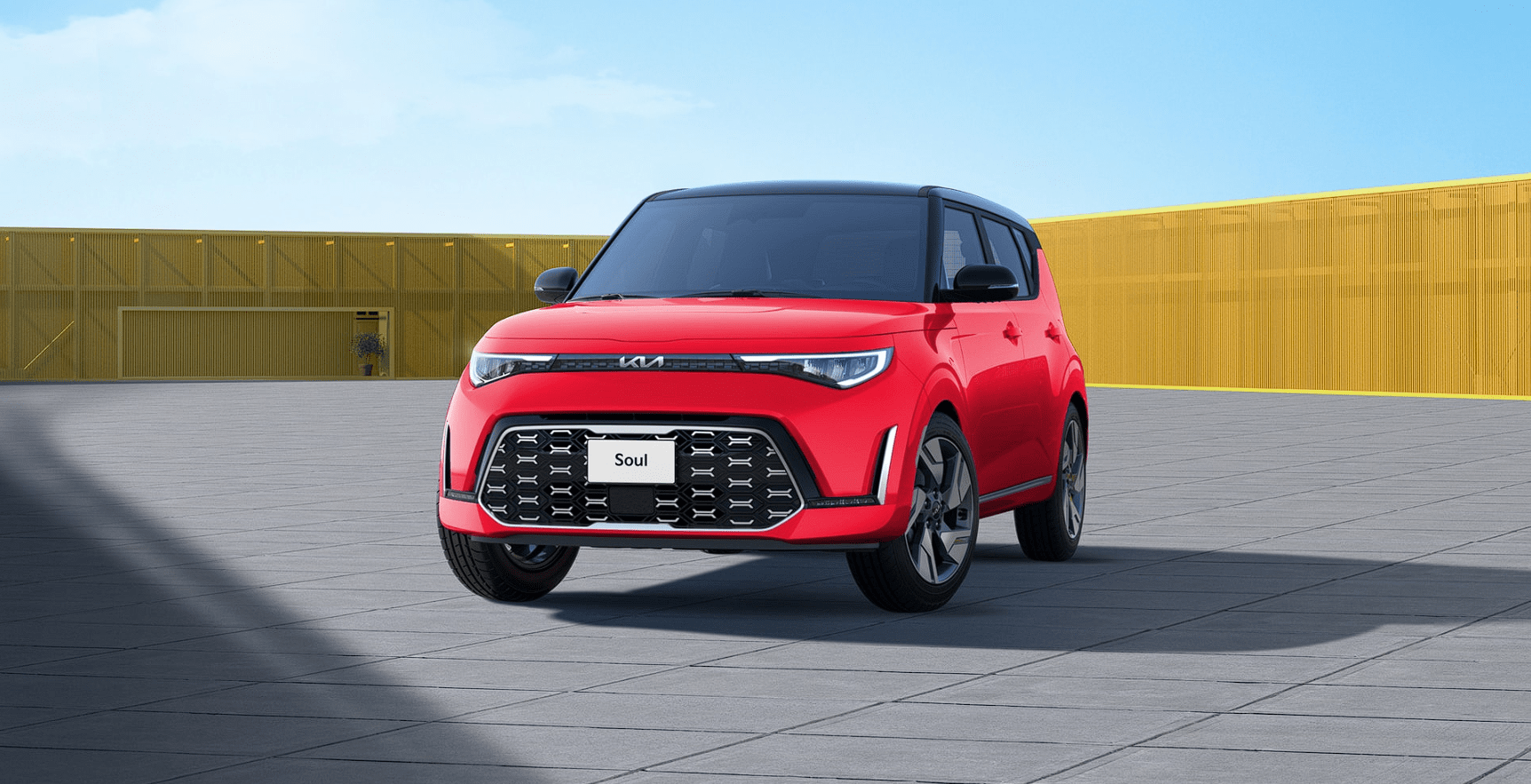Kia Soul 2023 Air Bag System User Manual
Introduction
The Kia Soul 2023 Air Bag System is a comprehensive safety feature that includes numerous airbags that are thoughtfully positioned all around the interior of the car. These airbags are made to inflate quickly in the event of a collision, reducing the risk of injuries by creating a soft barrier between passengers and the interior surfaces of the car.
The driver and front passenger front airbags are the main airbags in the Kia Soul 2023. These airbags, which are placed in the dashboard and steering wheel areas, deploy to protect the occupants’ heads and chests in a frontal collision. The Kia Soul 2023 has side-impact airbags in addition to the front airbags. The upper body and pelvis of the occupants are protected by these airbags, which typically are mounted in the seatbacks or doors. Additionally, the Kia Soul 2023 might include curtain airbags that are mounted on the sides of the roof. In the event of a rollover or side impact, these curtain airbags inflate to protect passengers in the front and back seats from head injuries.
The Kia Soul 2023‘s air bag system is a component of a comprehensive safety package that also includes seat belts, anti-lock brakes, stability control, and other cutting-edge safety features. Together, these safety features offer you and your passengers increased protection and peace of mind.
2023 Kia Soul Specs, Price, Features, Mileage (Brochure)
Air Bag System
Airbag – Advanced Supplemental Restraint System

The actual airbags in the vehicle may differ from the illustration.
- Driver’s front airbag
- Passenger’s front airbag
- Side airbag
- Curtain airbag
Even in vehicles with airbags, you and your passengers must always wear the safety belts provided in order to minimize the risk and severity of injury in the event of a collision or rollover.
How Does The Airbag System Operate?
- Air bags are activated (able to inflate if necessary) only when the ignition switch has been turned to the ON position.
- The appropriate airbags inflate instantly in the event of a serious frontal collision or side collision in order to help protect the occupants from serious physical injury.
- Generally, airbags are designed to inflate based on the severity of a collision and its direction, etc. These two factors determine whether the sensors produce an electronic deployment/inflation signal.
- Airbags will inflate based on the severity of a collision and its direction, etc. But Airbags will not inflate in every crash or collision situation.
- The front airbags will completely inflate and deflate in an instant. It is virtually impossible for you to see the airbags inflate during an accident. It is much more likely that you will simply see the deflated airbags hanging out of their storage compartments after the collision.
- In addition to inflating in serious side collisions, side and/or curtain airbags will inflate if the sensing system detects a rollover.
- When a rollover is detected, side and/or curtain airbags will remain inflated longer to help provide protection from ejection, especially when used in conjunction with seat belts.
- In order to help provide protection, the airbags must inflate rapidly. The speed of the airbag inflation is a consequence of the extremely short time in which to inflate the air bag between the occupant and the vehicle structures before the occupant impacts those structures. This speed of inflation reduces the risk of serious or life-threatening injuries and is thus a necessary part of airbag design. However, air bag inflation can also cause injuries which can include facial abrasions, bruises, and broken bones because the inflation speed also causes the airbags to expand with a great deal of force.
- There are even circumstances under which contact with the steering wheel or passenger airbag can cause fatal injuries, especially if the occupant is positioned excessively close to the steering wheel or passenger airbag.
WARNING
Airbag Inflation
Sit as far back as possible from the steering wheel while still maintaining comfortable control of the vehicle. A distance of at least 10 inches (25 cm) from your chest to the steering wheel is recommended. Failure to do so can result in airbag inflation injuries to the driver.
Noise and Smoke
When inflated, the airbags make a loud noise and leave smoke and powder in the air inside the vehicle. This is normal and is a result of the ignition of the airbag inflator. After the air bag inflates, you may feel substantial discomfort in breathing due to the contact of your chest with both the seat belt and the airbag, as well as from breathing the smoke and powder. Open your doors and/or windows as soon as possible after impact in order to reduce discomfort and prevent prolonged exposure to the smoke and powder. Though smoke and powder are non-toxic, it may cause irritation to the skin (eyes, nose, and throat, etc.). If this is the case, wash and rinse with cold water immediately and consult a doctor if the symptom persists.
Hot Components
Do not touch the airbag storage area’s internal components immediately after airbag inflation. The air bag-related parts in the steering wheel, instrument panel and the roof rails above the front and rear doors are very hot. Hot components can result in burn injuries.
WARNING
Do not install or place any accessories near air bag deployment areas, such as the instrument panel, windows, pillars, and roof rails.
Do not install a child restraint on the front passenger’s seat
Never place a rear-facing child restraint in the front passenger’s seat.

If the airbag deploys, it would impact the rear-facing child restraint, causing serious or fatal injury.
In addition, do not place front-facing child restraints in the front passenger seat. If the front passenger airbag inflates, it could cause serious or fatal injuries to the child.
WARNING
Airbag deployment
When children are seated in the rear outboard seats of a vehicle equipped with side and/or curtain airbags, install the child restraint system as far away from the door side as possible. Inflation of the side and/or curtain airbags could impact the child.
Airbag warning light
The purpose of the airbag warning light in your instrument panel is to alert you of a potential problem with your airbag system, which could include your side and/or curtain airbags used for rollover protection.
If the airbag warning light is illuminated for more than 6 seconds after the ignition switch has been turned to the ON position, or if it illuminates during vehicle operation, an SRS component may not be functioning properly and you should have your vehicle checked by an authorized Kia dealer.
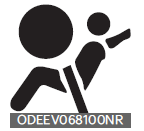
If any of the following conditions occur, this indicates a malfunction in the airbag system. Have an authorized Kia dealer inspect the airbag system as soon as possible.
- The light does not turn on briefly when you turn the ignition switch to the ON position.
- The light stays on after illuminating for approximately 6 seconds.
- The light comes on while the vehicle is in motion.
- The light blinks when the ignition switch to the ON position.
Supplemental Restraint System (SRS) Components and Functions
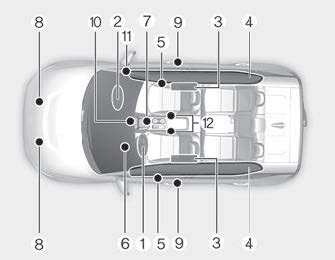
The actual position of SRS components may differ from the illustration.
The SRS consists of the following components:
- Driver’s front airbag module
- Passenger’s front airbag module
- Side airbag modules
- Curtain airbag modules
- Retractor pre-tensioner assemblies
- Airbag warning light
- SRS control module (SRSCM)
- Front impact sensors
- Side impact sensors
- Side pressure sensors
- An occupant detection system (Front passenger’s seat only)
- Front passenger’s seat belt buckle sensor
- Retractor pre-tensioner assemblies*
- if equipped
Driver’s front airbag (1)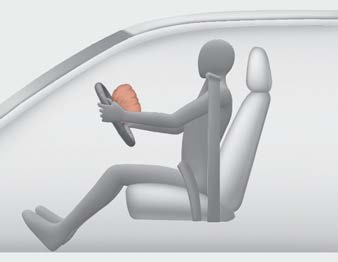
The front air bag modules are located both in the center of the steering wheel and in the front passenger’s panel above the glove box. When the SRSCM detects a sufficiently severe impact to the front of the vehicle, it will automatically deploy the front airbags.
Driver’s front air bag (2)
Upon deployment, tear seams molded directly into the pad covers will separate under pressure from the expansion of the air bags. Further opening of the covers then allows full inflation of the air bags.
Driver’s front air bag (3)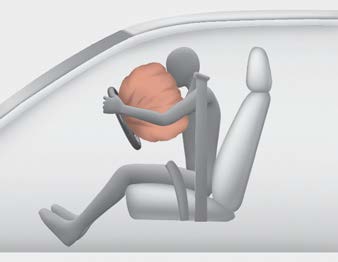
A fully inflated air bag, in combination with a properly worn seat belt, slows the driver’s or the passenger’s forward motion, reducing the risk of head and chest injury.
After complete inflation, the air bag immediately starts deflating, enabling the driver to maintain forward visibility and the ability to steer or operate other controls.
Passenger’s front air bag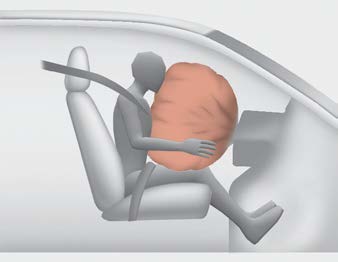
WARNING
Airbag obstructions
Do not install or place any accessories on the steering wheel, instrument panel, or on front passenger’s panel above the glove box in a vehicle. Such objects may become dangerous projectiles if the air bag deploys.
Flying objects
Do not place any objects (an umbrella, bag, etc.) between the front door and the front seat. Such objects may become dangerous projectiles if the side airbag inflates.
- If an air bag deploys, there may be a loud noise followed by fine dust released in the vehicle. These conditions are normal and are not hazardous – the air bags are packed in this fine powder. The dust generated during air bag deployment may cause skin or eye irritation as well as aggravate asthma for some persons. Always wash all exposed skin areas thoroughly with cold water and mild soap after an accident in which the air bags were deployed.
- The SRS can function only when the ignition switch is in the ON position. If the SRS air bag warning light does not illuminate or continuously remains on after illuminating for about 6 seconds when the ignition switch is turned to the ON position, or after the vehicle is in the ready mode, and comes on while driving, the SRS is not working properly. If this occurs, have your vehicle immediately inspected by an authorized Kia dealer.
NOTICE
Before you replace a fuse or disconnect a battery terminal, change the ignition switch to the OFF position. Never remove or replace the air bag related fuse(s) when the ignition switch is the ON position. Failure to heed this warning will cause the SRS air bag warning light to illuminate.
Occupant Detection System (ODS)
Your vehicle is equipped with an occupant detection system in the front passenger’s seat.
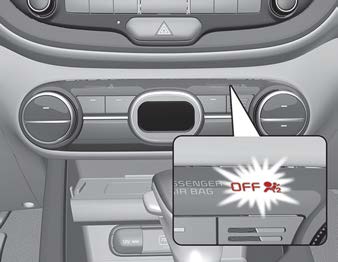
The occupant detection system is designed to detect the presence of a properly-seated front passenger and determine if the passenger’s front air bag should be enabled (may inflate) or not. Only the front passenger front air bag is controlled by the Occupant Detection System. Do not put anything in front of the passenger air bag ” ![]() ” indicator.
” indicator.
Main components of the occupant detection system
- An detection device located within the front passenger seat cushion.
- An electronic system which determines whether the passenger air bag systems should be activated or deactivated.
- An indicator light located on the instrument panel which illuminates the words PASSENGER AIR BAG “
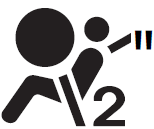 ” indicates the front passenger air bag system is deactivated.
” indicates the front passenger air bag system is deactivated. - The instrument panel air bag warning light is interconnected with the occupant detection system.
If the front passenger seat is occupied by a person that the system determines to be of appropriate size, and he/she sits properly (sit-ting upright with the seatback in an upright position, centered on the seat cushion with their seat belt on, legs comfortably extended and their feet on the floor), the PASSENGER AIR BAG “![]() ” indicator will turn off and the front passenger’s air bag will be able to inflate, if necessary, in frontal crashes. You will find the PASSENGER AIR BAG ”
” indicator will turn off and the front passenger’s air bag will be able to inflate, if necessary, in frontal crashes. You will find the PASSENGER AIR BAG ” ![]() ” indicator on the center fascia panel. This system detects the conditions 1~4 in the following table and activates or deactivates the front passenger air bag based on these conditions. Always be sure that you and all vehicle occupants are seated and restrained properly (sitting upright with the seat in an upright position, centered on the seat cushion, with the person’s legs comfortably extended, feet on the floor, and wearing the safety belt properly) for the most effective protection by the air bag and the safety belt.
” indicator on the center fascia panel. This system detects the conditions 1~4 in the following table and activates or deactivates the front passenger air bag based on these conditions. Always be sure that you and all vehicle occupants are seated and restrained properly (sitting upright with the seat in an upright position, centered on the seat cushion, with the person’s legs comfortably extended, feet on the floor, and wearing the safety belt properly) for the most effective protection by the air bag and the safety belt.
- The ODS (Occupant Detection System) may not function properly if the passenger takes actions which can defeat the detection system. These include:
- Failing to sit in an upright position.
- Leaning against the door or center console.
- Sitting towards the sides or the front of the seat.
- Putting legs on the dashboard or resting them on other locations which reduce the passenger weight on the front seat.
- Improperly wearing the safety belt.
- Reclining the seatback.
Condition and operation in the front passenger occupant detection system
| Condition Detected by The Occupant Classification System | Indicator/Warning Light | Devices | |
| “PASSENGER AIR BAG OFF” Indicator Light |
SRS Warning Light | Front Passenger Air Bag | |
| 1. Adult*1 | Off | Off | Activated |
| 2. Child restraint system with child under 12 months old*2*3*4 | On | Off | Deactivated |
| 3. Unoccupied | On | Off | Deactivated |
| 4. Malfunction in the system | Off | On | Activated |
- The system judges a person of adult size as an adult. When a smaller adult sits in the front passenger seat, the system may recognize him/her as a child depending on his/her physique and posture.
- Do not allow children to ride in the front passenger seat. When a larger child who has outgrown a child restraint system sits in the front passenger seat, the system may recognize him/her as an adult depending upon his/her physique or sit-ting position.
- Never install a child restraint system on the front passenger seat.
- The PASSENGER AIR BAG ” ” indicator may turn on or off when a child above 12 months to 12 years old (with or without child restraint system) sits in the front passenger seat. This is a normal condition.
WARNING
- Do not install a child restraint system in the passenger seat when the seat is heavily soaked with any type of liquid.
- Do not alter or remodel the ODS (Occupant Detection System). This may damage the system and prevent its proper function in a collision.
NOTICE
- Do not use car seat cushions that cover up the surface of the seat and aftermarket manufactured passenger seat heaters.
- After conducting car interior cleaning using steam or deter-gent, the seat should be dried properly. Afterward, check for normal operation of the PASSEN-GER AIR BAG “OFF” and air bag warning lights.
- Any service related to the passenger seat and the ODS must be done at an authorized Kia service center.
- After the passenger seat has been removed or installed for repair purposes, check for normal operation of the PASSENGER AIR BAG “
 ” and air bag warning lights with a person seated or not seated in the passenger seat.
” and air bag warning lights with a person seated or not seated in the passenger seat.
WARNING
When the PASSENGER AIR BAG ” ![]() ” symbol is illuminated, the passenger air bag system will not operate. The passenger air bag system will operate when necessary if the symbol is not illuminated.
” symbol is illuminated, the passenger air bag system will not operate. The passenger air bag system will operate when necessary if the symbol is not illuminated.
NOTICE
Do not modify or replace the front passenger seat. Do not place any-thing on or attach anything, such as a blanket, front seat cover or after market seat heater, to the front passenger seat. This can adversely affect the occupant detection system.
WARNING
ODS System
Riding in an improper position adversely affects the Occupant Detection System and may result in the deactivation of the front passenger airbag. It is important for the driver to instruct the passenger as to the proper seating instructions as contained in this manual.
- Do not place a heavy load in the front passenger seatback pocket or on the front passenger seat.
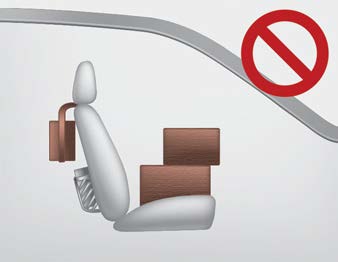
- Do not place feet on the front passenger seatback.
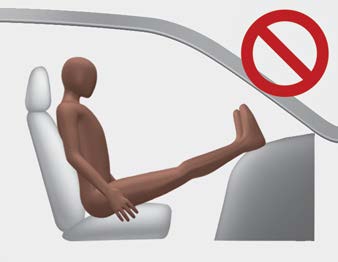
- Never sit with hips shifted towards the front of the seat.

- Never excessively recline the front passenger seatback.

- Never place feet on the dashboard.

- Never lean on the door or center console.
- Never sit on one side of the front passenger seat.
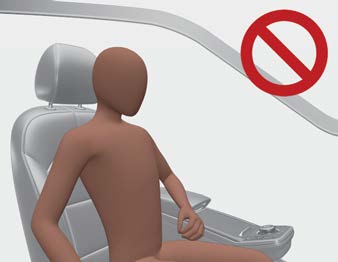
- Do not use car seat accessories, such as thick blankets and cushions, that cover up the car seat surface.
- Do not sit on the passenger seat wearing heavily padded clothes, such as ski wear and hip protector.

- Do not place electronic devices, such as laptops and DVD player, or conductive materials, such as water bottles, on the passenger seat.
- Do not use electronic devices, such as laptops and satellite radios, that use inverter chargers.

- Wet Passenger Seat
Do not spill liquid in the passenger seat. Spilled liquid on the passenger seat may cause the air bag warning light to illuminate or mal-function. If any liquid is spilled, make sure the seat has been completely dried before driving the vehicle.
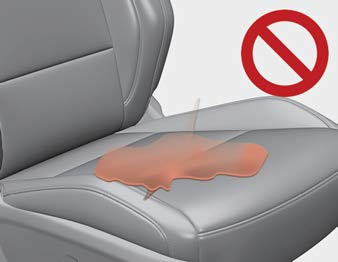
Proper Position

When an adult is seated in the front passenger seat, if the PASSENGER AIR BAG ![]() indicator is on, change the ignition switch to the OFF position and ask the passenger to sit properly (sitting upright with the seatback in an upright position, centered on the seat cushion with their seat belt on, legs comfortably extended and their feet on the floor). Restart the vehicle and have the person remain in that position. This will allow the system to detect the person and to enable the passenger airbag.
indicator is on, change the ignition switch to the OFF position and ask the passenger to sit properly (sitting upright with the seatback in an upright position, centered on the seat cushion with their seat belt on, legs comfortably extended and their feet on the floor). Restart the vehicle and have the person remain in that position. This will allow the system to detect the person and to enable the passenger airbag.
If the PASSENGER AIR BAG ” indicator is still on, ask the passengers to move to the rear seat.
WARNING
PASSENGER AIR BAG ![]() light
light
Do not allow an adult passenger to ride in the front seat when the PAS-SENGER AIR BAG ” ![]() ” indicator is illuminated, because the airbag will not deploy in the event of a crash. The driver must instruct the passenger to reposition himself in the seat. Failure to properly position himself may lead to air bag deactivation, resulting in airbag non-deployment in a collision. If the PAS-SENGER AIR BAG ” ” indicator remains illuminated after the passenger repositions itself properly and the car is restarted, it is recommended that the passenger moves to the rear seat because the passenger’s front airbag will not deploy.
” indicator is illuminated, because the airbag will not deploy in the event of a crash. The driver must instruct the passenger to reposition himself in the seat. Failure to properly position himself may lead to air bag deactivation, resulting in airbag non-deployment in a collision. If the PAS-SENGER AIR BAG ” ” indicator remains illuminated after the passenger repositions itself properly and the car is restarted, it is recommended that the passenger moves to the rear seat because the passenger’s front airbag will not deploy.
NOTICE
The PASSENGER AIR BAG “![]() ” indicator illuminates for about 4 seconds after the ignition switch is turned to the ON position after the vehicle is started. If the front passenger seat is occupied, the occupant detection sensor will then classify the front passenger after several more seconds.
” indicator illuminates for about 4 seconds after the ignition switch is turned to the ON position after the vehicle is started. If the front passenger seat is occupied, the occupant detection sensor will then classify the front passenger after several more seconds.
- Even though your vehicle is equipped with the occupant detection system, never install a child restraint system in the front passenger’s seat. A deploying air bag can forcefully strike a child resulting in serious injuries or death.
Any child age 12 and under should ride in the rear seat. Children too large for child restraints should use the available lap/shoulder belts. No matter what type of crash, children of all ages are safer when restrained in the rear seat. If the occupant detection system is not working properly, the SRS air bag warning light on the instrument panel will illuminate because the passenger’s front air bag is connected with the occupant detection system. If there is a malfunction of the occupant detection system, the PASSENGER AIR BAG ” “indicator will not illuminate and the passenger’s front air bag will inflate in frontal impact crashes even if there is no occupant in the front passenger seat.
Driver’s and Passenger’s Front Air Bag
Your vehicle is equipped with an Advanced Supplemental Restraint (Air Bag) System and lap/shoulder belts at both the driver and passenger seating positions.
Driver’s Front Airbag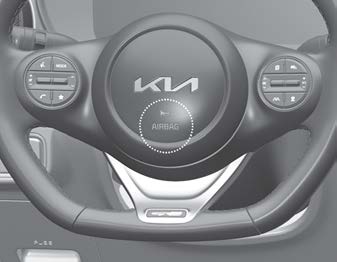
Passenger’s Front Airbag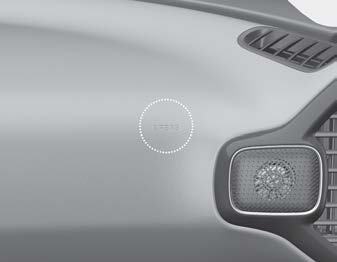
The indication of the system’s presence is the letters “AIR BAG” located on the air bag pad cover on the steering wheel and the passenger side front panel pad above the glove box.
The SRS consists of airbags installed under the pad covers in the center of the steering wheel and the passenger’s side front panel above the glove box.
The purpose of the SRS is to provide the vehicle’s driver and/or the front passenger with additional protection than that offered by the seat belt system alone in case of a frontal impact of sufficient severity. The SRS uses sensors to gather information about the driver’s and front passenger’s seat belt usage and impact severity.
The seat belt buckle sensor determines if the front passenger’s seat belt is fastened.
These sensors provide the ability to control the SRS deployment based on whether or not the seat belts are fastened, and how severe the impact is.
The advanced SRS offers the ability to control airbag inflation with two levels. A first-stage level is provided for moderate-severity impacts. A second stage level is provided for more severe impacts.
The passenger’s front airbag is designed to help reduce the injury of children sitting close to the instrument panel in low-speed collisions. However, children are safer if they are restrained in the rear seat.
According to the impact severity and seat belt usage, the SRSCM (SRS Control Module) controls the air bag inflation. Failure to properly wear seat belts can increase the risk or severity of injury in an accident.
Additionally, your vehicle is equipped with an occupant detection system in the front passenger’s seat. The occupant detection system detects the presence of a passenger in the front passenger’s seat and will turn off the front passenger’s air bag under certain conditions. For more detail, see “Occupant Detection System (ODS)” on pages 3-47.
WARNING
Modification to the seat structure can cause the air bag to deploy at a different level than should be provided.
Manufacturers are required by government regulations to provide a contact point concerning modifications to the vehicle for persons with disabilities, which modifications may affect the vehicle’s advanced air bag system. That contact is Kia’s toll-free Customer Assistance center at 1-800-333-4Kia. However, Kia does not endorse nor will it support any changes to any part or structure of the vehicle that could affect the advanced air bag system, including the occupant detection system.
WARNING
Replacement/Modifications
The front passenger seat, dash-board or door should not be replaced except by an authorized Kia dealer using original Kia parts designed for this vehicle and model. Any other such replacement or modification could adversely affect the operation of the occupant detection system and your advanced air bags. Advanced air bags are combined with pre-tensioner seat belts to help provide enhanced occupant protection in frontal crashes. Front air bags are not intended to deploy in collisions in which sufficient protection can be provided by the seat belt.
NOTICE
Air bags can only be used once an authorized Kia dealer replaces the air bag immediately after deployment. Front air bags are not intended to deploy in side-impact, rear-impact or rollover crashes. However, when frontal deployment threshold is satisfied at side-impact, front air bags may deploy. In addition, front air bags will not deploy in frontal crashes below the deployment threshold.
WARNING
SRS Wiring
Do not tamper with or disconnect SRS wiring or other components of the SRS system. Doing so could result in injury, due to accidental deployment of the airbags or by rendering the SRS inoperative.
No Attaching Objects
No objects (such as crash pad cover, cellular phone holder, cup holder, perfume or stickers) should be placed over or near the airbag modules on the steering wheel, instrument panel, windshield glass, and the front passenger’s panel above the glove box. Such objects could cause harm if the vehicle is in a crash severe enough to cause the airbags to deploy.
Do not place any objects over the air bag or between the air bag and yourself. Additionally, never place or insert any object into any small opening near side airbag labels attached to the vehicle seats.
When the air bag deploys, the object may affect the deployment and result in an unexpected accident or bodily harm.
Side Airbag
Your vehicle is equipped with a side airbag in each front seat.
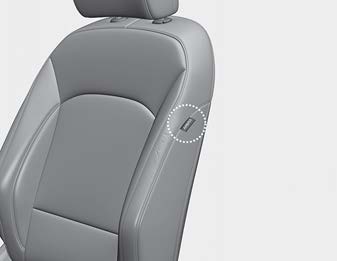
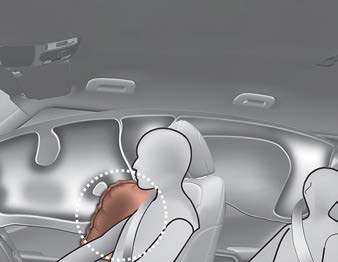
- The actual airbags in the vehicle may differ from the illustration.
- The purpose of the airbag is to provide the vehicle’s driver and/or the front passenger with additional protection than that offered by the seat belt alone.
- The side airbags are designed to deploy during certain side-impact collisions, depending on the crash severity of impact.
- The side airbags may deploy on the side of the impact or on both sides.
- The side and/or curtain airbags on both sides of the vehicle will deploy if a rollover or possible rollover is detected.
- The side airbags are not designed to deploy in all side impact or roll-over situations.
WARNING
Unexpected Deployment
Avoid impact to the side impact air-bag sensor when the ignition switch is ON to prevent unexpected deployment of the side airbag.
- The side airbag is supplemental to the driver’s and the passenger seat belt systems and is not a substitute for them. Therefore your seat belts must be worn at all times while the vehicle is in operation.
- For best protection from the side air bag system and to avoid being injured by the deploying side air bag, both front seat occupants should sit in an upright position with the seat belt properly fastened. The driver’s hands should be placed on the steering wheel at the 9:00 and 3:00 positions. The passenger’s arms and hands should be placed on their laps.
Deployment
Do not install any accessories including seat covers, on the side or near the side airbag, as this may adversely affect the deployment of the side airbags.
- If seat or seat cover is damaged, have the vehicle checked and repaired by an authorized Kia dealer? Inform the dealer that your vehicle is equipped with side airbags and an occupant detection system.
WARNING
Flying Objects
Do not place any objects (an umbrella, bag, etc.) between the front door and the front seat. Such objects may become dangerous projectiles if the side airbag inflates.
WARNING
No Attaching Objects
- Do not place any objects over the air bag or between the air bag and your-self. Also, do not attach any objects around the area in which the air bag inflates, such as the door, side door glass, front and rear pillar.
- Do not put any objects between the side airbag label and seat cushion. It could cause harm if the vehicle is in a crash severe enough to cause the air bags to deploy.
- Never place or insert any object into any small opening near the side airbag labels attached to the vehicle seats. When the air bag deploys, the object may adversely affect the deployment and result in an unexpected accident or bodily harm.
- Do not install any accessories on the side or near the side air bags.
Curtain Air Bag
Curtain air bags are located along both sides of the roof rails above the front and rear doors.
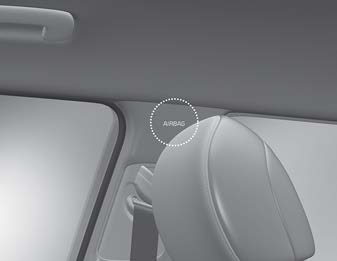
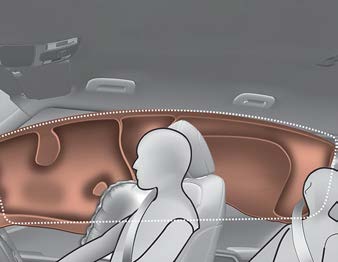
- * The actual air bags in the vehicle may differ from the illustration.
They are designed to help protect occupants in certain side impacts and to help prevent them from ejecting out of the vehicle as a result of a rollover, especially when the seatbelts are also in use. - The curtain air bags are designed to deploy during certain side impact collisions, depending on the severity of impact. However, when side deployment threshold is satisfied at front-impact, side air bags may deploy.
- The curtain air bags may deploy on the side of the impact or on both sides.
Also, the curtain air bags on both sides of the vehicle will deploy in certain rollover situations. - The curtain air bags are not designed to deploy in all side impact or rollover situations.
Do not allow the passengers to lean their heads or bodies against the doors, put their arms on the doors, stretch their arms out of the window or place objects between the doors and passengers when they are seated on seats equipped with side impact and/or curtain air bags.
NOTICE
Never try to open or repair any components of the side and curtain air bag system. This should only be done by an authorized Kia dealer.
WARNING
No Attaching Objects
- Do not place any objects over the air bag. Also, do not attach any objects around the area in which the air bag inflates, such as the door, side door glass, front and rear pillar, roof side rail.
Do not hang hard, breakable, or heavy objects on the coat hooks for safety reasons.
Air Bag Collision Sensors
The air bag collision sensors are located in the following positions
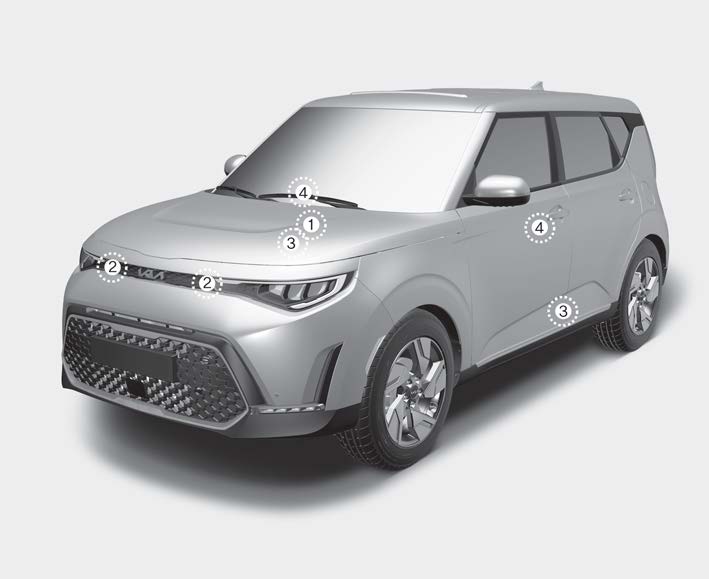

* The actual shape and position of sensors may differ from the illustration.
- SRS control module / Rollover sensor
- Front impact sensor
- Side impact sensor
- Side pressure sensor
WARNING
Air Bag Sensors
- Do not hit or allow any objects to impact the locations where air bags or sensors are installed.
This may cause unexpected air bag deployment, which could result in serious personal injury or death. - If the installation location or angle of the sensors is altered in any way, the air bags may deploy when they should not or they may not deploy when they should.
Therefore, do not try to perform maintenance on or around the air bag sensors. Have the vehicle checked and repaired by an authorized Kia dealer. - Problems may arise if the sensor installation angles are changed due to the deformation of the front bumper, front end module, body or front doors where side collision sensors are installed. Have the vehicle checked and repaired by an authorized Kia dealer.
Installing bumper guards (or side step or running board) or replacing a bumper (or front door module) with non-genuine parts may adversely affect your vehicle’s collision and air bag deployment performance.
Kia Genuine bumper guards/bumpers are parts we guarantee for quality and performance.
Why didn’t my air bag go off in a collision? (Inflation and non-inflation conditions of the air bag)
There are many types of accidents in which the air bag would not be expected to provide additional protection.
These include rear impacts, second or third collisions in multiple impact accidents, as well as low speed impacts.
Air Bag Inflation Conditions
Front Air Bags
Front air bags are designed to inflate in a frontal collision depending on the severity of impact of the front collision.
Side and/or Curtain Air Bags
Side and/or curtain air bags are designed to inflate when an impact is detected by side collision sensors depending on the severity of impact resulting from a side impact collision.
Also, the side and curtain air bags are designed to inflate when a rollover is detected by a rollover sensor.
Although the front air bags (driver’s and front passenger’s air bags) are primarily designed to inflate in frontal collisions, they may inflate in other types of collisions if the front impact sensors detect a sufficient frontal force in another type of impact.
Similarly, although side and curtain air bags are designed to inflate in certain side impact collisions, they may inflate in other types of collisions where a side force is detected by the sensors. For instance, side air bag and/or curtain air bags may inflate if rollover sensors indicate the possibility of a rollover occur-ring (even if none actually occurs) or in other situations, including when the vehicle is tilted while being towed.
Even if side and/or curtain air bags do not provide impact protection in a roll-over, they will deploy to prevent ejection of occupants, especially those who are restrained with seat belts.
If the vehicle chassis is impacted by bumps or objects on unimproved roads, the air bags may deploy. Drive carefully on unimproved roads or on surfaces not designed for vehicle traffic to prevent unintended air bag deployment.
Air Bag Non-Inflation Conditions
- In certain low-speed collisions the airbags may not deploy. The air bags are designed not to deploy in such cases because they may not provide bene-fits beyond the protection of the seat belts in such collisions.
- Air bags are not designed to inflate in rear collisions, because occupants are moved backward by the force of the impact. In this case, inflated air bags would not be able to provide any additional benefit.
- Front air bags may not inflate in side impact collisions, because occupants move to the direction of the collision, and thus in side impacts, frontal air bag deployment would not provide additional occupant protection.
- In an angled collision, the force of impact may direct the occupants in a direction where the air bags would not be able to provide any additional benefit, and thus the sensors may not deploy any air bags.
- Just before impact, drivers often brake heavily. Such heavy braking lowers the front portion of the vehicle causing it to “ride” under a vehicle with a higher ground clearance. Air bags may not inflate in this “under-ride” situation because deceleration forces that are detected by sensors may be significantly reduced by such “under-ride” collisions.
- Front air bags may not inflate in all rollover accidents when the SRSCM indicates that the front air bag deployment would not provide additional occupant protection.
- Air bags may not inflate if the vehicle collides with objects such as utility poles or trees, where the point of impact is concentrated to one area and the full force of the impact is not delivered to the sensors.
Supplemental Restraint System (SRS) Care
The SRS is virtually maintenance-free and so there are no parts you can safely service by yourself.
If the SRS air bag warning light does not appear, or continuously remains on, have your vehicle immediately inspected by an authorized Kia dealer.
Any work on the SRS system, such as removing, installing, repairing, or any work on the steering wheel, the front passenger’s panel, front seats and roof rails must be performed by an authorized Kia dealer. Improper handling of the SRS system may result in serious personal injury.
For cleaning the air bag pad covers, use only a soft, dry cloth or one which has been moistened with plain water. Solvents or cleaners could adversely affect the air bag covers and proper deployment of the system.
If components of the air bag system must be discarded, or if the vehicle must be scrapped, certain safety precautions must be observed. An authorized Kia dealer knows these precautions and can give you the necessary information. Failure to follow these precautions and procedures could increase the risk of personal injury.
WARNING
Tampering with SRS
Do not tamper with or disconnect SRS wiring, or other components of the SRS system. Doing so could result in the accidental inflation of the air bags or render the SRS inoperative.
WARNING
Towing Vehicle
Always have the ignition off when your vehicle is being towed. The side air bags may inflate if the vehicle is tilted, such as when being towed, because of the roll-over sensors in the vehicle.
Adding equipment to or modify-ing your air bag-equipped vehicle
If you modify your vehicle by changing your vehicle’s frame, bumper system, front end or side sheet metal or ride height, this may affect the operation of your vehicle’s air bag system.
Air Bag Warning Label
Air bag warning labels, some required by the U.S. National Highway Traffic Safety Administration (NHTSA), are attached to the sun visor to alert the driver and passengers of potential risks of the air bag system.
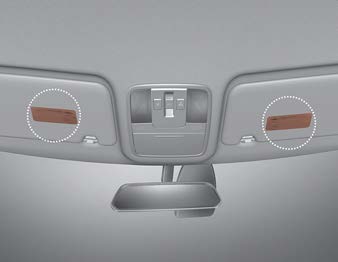
FAQs
- What type of airbags does the Kia Soul 2023 have?
The Kia Soul 2023 has full-length side curtain airbags, front-seat mounted side airbags, and dual front airbags. - How many airbags are there in the Kia Soul 2023?
Six airbags are present in the Kia Soul 2023, including dual front airbags, side airbags mounted on the front seats, and full-length side curtain airbags. - Are there airbags for the rear passengers in the Kia Soul 2023?
The Kia Soul 2023 lacks separate airbags for the backseat occupants. However, all passengers, including those in the back seats, are protected by the side curtain airbags. - Is there a passenger occupancy sensor for the front airbags?
Yes, the front airbags in the Kia Soul 2023 are equipped with a passenger occupancy sensor. By adjusting the airbag deployment accordingly, it assists in determining whether the front passenger seat is occupied. - Are there side airbags for the rear seats?
There are no separate side airbags for the back seats in the Kia Soul 2023. All occupants, including those in the back seats, are protected by the full-length side curtain airbags. - Can the airbags be disabled in the Kia Soul 2023?
The Kia Soul 2023’s airbags cannot be manually turned off. In the event of a serious collision, they are intended to automatically deploy. - Does the Kia Soul 2023 have knee airbags?
No, knee airbags are not a feature of the Kia Soul 2023. It has full-length side curtain airbags, front-seat mounted side airbags, and dual front airbags. - Does the Kia Soul 2023 have an airbag cutoff switch for child seats?
The Kia Soul 2023 does not have a child seat airbag cutoff switch. In order to reduce the risk of injury from airbag deployment, it is advised to install child seats in the back seats. - How does the airbag system in the Kia Soul 2023 work?
The Kia Soul 2023’s airbag system uses a number of sensors to identify collision forces. The system initiates the deployment of the appropriate airbags to protect the occupants when a significant impact is detected. - Are the airbags in the Kia Soul 2023 designed to deploy in all types of collisions?
The Kia Soul 2023’s airbags are primarily made to inflate in frontal and side collisions that range from mild to severe. To determine airbag deployment, the system considers a number of variables, including impact force, direction, and occupant position. - Are the airbags in the Kia Soul 2023 reusable after deployment?
The airbags in the Kia Soul 2023 cannot be used again or reinstalled after they have been deployed. The airbags must be replaced by a trained technician after deployment. - How long do the airbags in the Kia Soul 2023 stay inflated after deployment?
In order to help cushion the occupants during the initial impact, the airbags in the Kia Soul 2023 typically stay inflated for a very brief period of time, usually a fraction of a second. After that, they quickly deflate.
Useful Links
View Full User Guide: Kia Soul 2023 Owner’s Manual | Auto User Guide
Download Manuals: Kia | Owner’s Manuals and Documents

